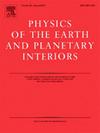印度记录的XKS和SKKS相分裂强度的差异证明了地幔最下层各向异性
IF 1.9
3区 地球科学
Q2 GEOCHEMISTRY & GEOPHYSICS
引用次数: 0
摘要
本研究综合考察了在印度357个宽带站记录的相同地震记录上的XKS (SKS和PKS) - SKKS对剪切波分裂测量结果,以表征最下层地幔的各向异性。结果在62个站点鉴定了104对XKS-SKKS,根据XKS分裂强度和相应SKKS阶段的差异,发现27对XKS-SKKS存在差异。这些差异对主要是在东南亚和印度洋下的最下层地幔的一部分取样。这些对大多数代表null-split和split-split情况,其中SKKS的延迟时间大于XKS的延迟时间。这表明XKS相主要对各向同性(弱各向异性)或各向异性区域进行采样,并在最下层地幔中起到抵消作用,而对应的SKKS相则对D″层的各向异性区域进行采样。这意味着在XKS和SKKS取样的区域,D″层的各向异性发生了明显变化,尽管它们与高速异常有关。在这些区域,差值对的快速极化方位角分别在NE-SW和ENE-WSW方向,以及NNE-SSW方向。这些与最底地幔的地幔流动趋势不一致,表明与古俯冲板块有关。观测到的变形可能是由桥菱矿向更稳定的后钙钛矿相变引起的,导致了最下层地幔的晶体优先取向,这是东南亚和印度洋最下层地幔各向异性的候选机制。本文章由计算机程序翻译,如有差异,请以英文原文为准。
Evidence for lowermost mantle anisotropy from discrepant splitting intensity of XKS and SKKS phases recorded in India
This study comprehensively examines the shear wave splitting measurements of XKS (SKS and PKS) - SKKS pairs on the same seismograms recorded at 357 broadband stations spanning India, to characterize anisotropy in the lowermost mantle. This resulted in the identification of 104 XKS-SKKS pairs at 62 stations, of which 27 pairs were found to be discrepant, based on the difference in splitting intensity of XKS and the corresponding SKKS phases. These discrepant pairs dominantly sample a portion of the lowermost mantle beneath Southeast Asia and the Indian Ocean. The majority of these pairs represent null-split and split-split cases, with the delay time of SKKS being larger than that of XKS for the latter. This suggests that the XKS phases primarily sample the isotropic (weakly anisotropic) or anisotropic regions with a cancelling effect in the lowermost mantle, while the corresponding SKKS phases sample the anisotropic region of the D layer. In addition, there are three discrepant pairs in the split-null category, suggesting anisotropy in the vicinity of southern Tibet, where discrepant pairs from other cases are not observed. This implies an apparent change in the anisotropy of the D layer for the regions sampled by XKS and SKKS, although they are associated with high-velocity anomalies. In these regions, the fast polarization azimuths of the discrepant pairs are in the NE-SW and ENE-WSW, and NNE-SSW directions, respectively. These do not coincide with the trend of mantle flow in the lowermost mantle, suggesting an association with paleo-subducted slabs. The observed deformation is probably due to phase transformation of bridgmanite to a more stable post-perovskite, causing Crystallographic Preferred Orientation of the lowermost mantle, which is the candidate mechanism for lowermost mantle anisotropy beneath Southeast Asia and the Indian Ocean.
求助全文
通过发布文献求助,成功后即可免费获取论文全文。
去求助
来源期刊

Physics of the Earth and Planetary Interiors
地学天文-地球化学与地球物理
CiteScore
5.00
自引率
4.30%
发文量
78
审稿时长
18.5 weeks
期刊介绍:
Launched in 1968 to fill the need for an international journal in the field of planetary physics, geodesy and geophysics, Physics of the Earth and Planetary Interiors has now grown to become important reading matter for all geophysicists. It is the only journal to be entirely devoted to the physical and chemical processes of planetary interiors.
Original research papers, review articles, short communications and book reviews are all published on a regular basis; and from time to time special issues of the journal are devoted to the publication of the proceedings of symposia and congresses which the editors feel will be of particular interest to the reader.
 求助内容:
求助内容: 应助结果提醒方式:
应助结果提醒方式:


